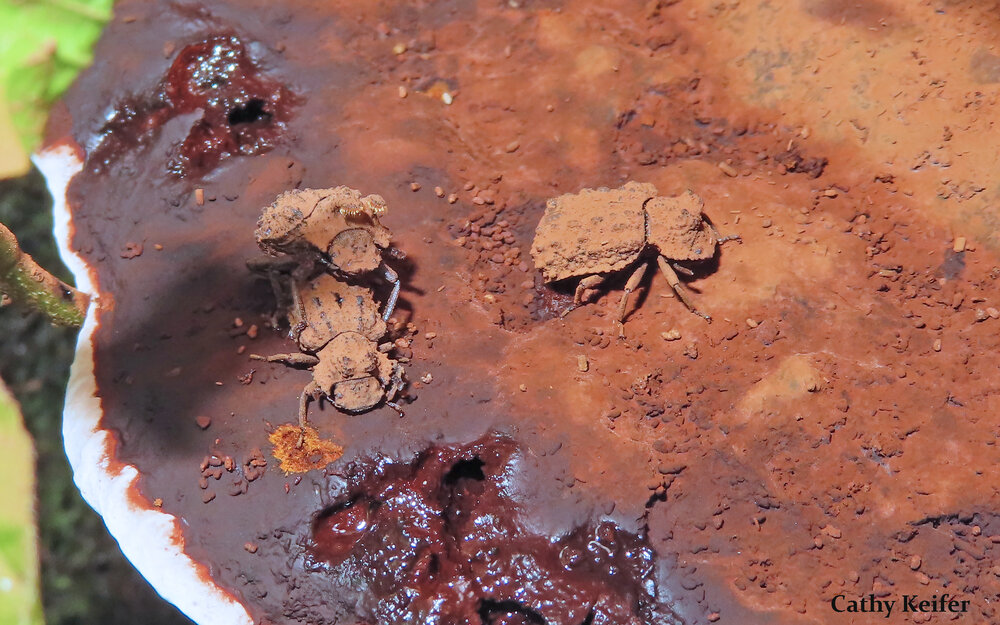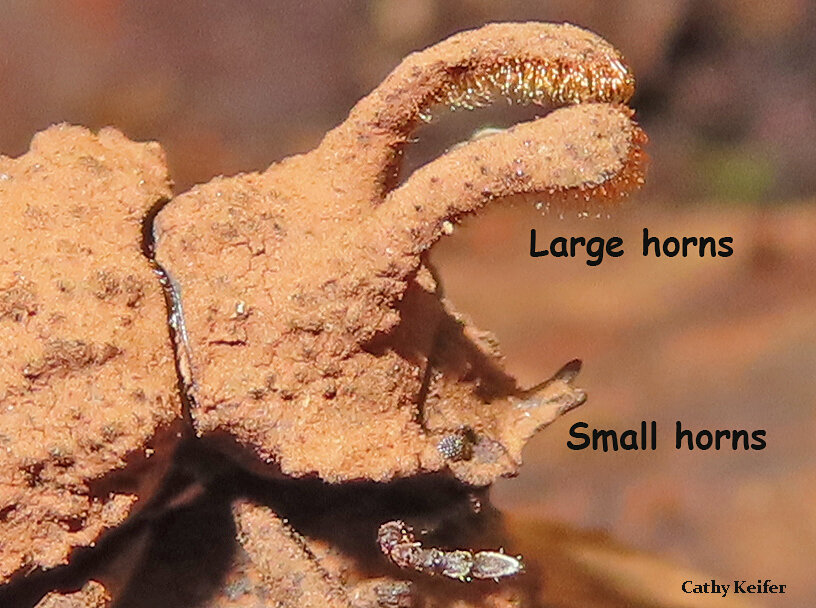For horny beetles, size does matter: Forked Fungus Beetle, Bolitotherus cornutus

Bracket fungi are the stage for romance and rivalry of forked fungus beetles. Photo by Cathy Keifer
Wood is composed of several compounds but, most notably, two really tough polymers you probably have heard of called cellulose and lignin. Fungi are one of but a few organisms able to breakdown these carbon-rich compounds and return these molecules to food webs. Without fungi recycling fallen trees, our forests would cease to exist as the dynamic wonderlands we enjoy today. Fungi turn wood into hyphae and fruiting bodies which in turn become food for creatures higher up the food web, including hundreds of species of insects. This week Bug of the Week dives into the email bag to share some marvelous images of really cool beetles whose lives depend on fungi as a source of food and as a stage for romance.

Male forked fungus beetles use large upper horns and smaller lower horns to battle for possession of their mate. Photo by Cathy Keifer
The forked fungus beetle belongs to a large family of beetles called darkling beetles, Tenebrionidae (previously we met other members of this clan in their winter refuge beneath the bark of a tree). As their name implies, both larval and adult forked fungus beetles consume and thrive on nutrients contained in the tissues and spores of fungi. Bracket fungi in the genera Ganoderma and Fomes are reported to be favored hosts. Female beetles deposit eggs on the surface of the bracket fungus and larvae tunnel in and feed on nutritive hyphae. The forked fungus beetles we meet today were photographed in September 2020 on the surface of the bracket fungus where courtship battles often take place. The large horns curling above the head of the fungus beetles occur only on males. They play a key role in competitive interactions with other males for opportunities to mate with very cute but hornless female beetles. Male beetles can often be found guarding bracket fungi where they chase away other males, potential rivals, and thereby monopolize the critical resource needed by females to lay eggs. One study found that males with larger horns had a greater chance of mating success than males with smaller horns.
Combat between two forked fungus beetle (Bolithoterus cornutus) males. The larger attacking male uses his clypeal horns in an attempt to dislodge the smaller male. The smaller male was previously courting the female and during the combat grips her with all six legs. The video has been sped up to 5x actual speed. Please visit the source of this video in the following amazing article: K.M. Benowitz, E.D. Brodie III, V.A. Formica (2012) Morphological Correlates of a Combat Performance Trait in the Forked Fungus Beetle, Bolitotherus cornutus. PLoS ONE 7(8): e42738. https://doi.org/10.1371/journal.pone.0042738

Lovely female beetles lack the prominent horns of their male suitors. Photo by Cathy Keifer
In addition to the prominent horns curling above the head of the male, a smaller pair of horns is present near the eyes at the front of the beetle’s face. So, other than looking marvelous, of what use are the horns? As part of the mating ritual, a male beetle will climb atop his mate and guard his intended for up to five hours while intermittently attempting to mate with her. Scientists have observed amorous male beetles using their two sets of horns “like a wedge and a bottle opener” to dislodge already engaged males from the female and thereby assert themselves as the winning suitor. In this battle to procreate, scientists have found that large beetles, ones with larger horns, are stronger than smaller beetles. Their powerful grip may make big beetles with big horns more difficult to dislodge from their mate than smaller males with puny horns. In forked fungus beetles and many other animals, yes, size does matter.
Acknowledgements
We thank Cathy Keifer for providing the inspiration and marvelous images used in this episode. The remarkable articles “Morphological Correlates of a Combat Performance Trait in the Forked Fungus Beetle, Bolitotherus cornutus” by K.M. Benowitz, E.D. Brodie III, and V.A. Formica, and “Common name: forked fungus beetle (suggested common name) Scientific name: Bolitotherus cornutus (Panzer) 1794 (Insecta: Coleoptera: Tenebrionidae)” by Ummat Somjee and Andrea Lucky provided information used in this episode. Please learn more about forked fungus beetles at the following links:
https://journals.plos.org/plosone/article?id=10.1371/journal.pone.0042738
http://entnemdept.ufl.edu/creatures/misc/beetles/forked_fungus_beetle.htm
This post appeared first on Bug of the Week